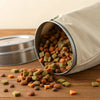How to Freeze Dry Food for Dogs: A Comprehensive Guide for Pet Owners
- Houndsy
Table of Contents
- Introduction
- Understanding Freeze-Drying
- The Freeze-Drying Process for Dog Food
- Tailoring Recipes to Your Dog's Needs
- Common Myths About Freeze-Drying
- Integrating Freeze-Dried Food into Your Dog's Diet
- Potential Challenges and Solutions
- Conclusion
Introduction
Did you know that freeze-dried food can retain up to 97% of its nutrients, making it a fantastic option for our furry friends? As pet owners, we all want the best for our dogs, ensuring they receive nutritious meals that promote their health and happiness. However, the pet food market can be overwhelming, filled with products that often contain preservatives and questionable ingredients. This is where freeze-drying comes into play, offering a method that not only preserves the nutritional integrity of ingredients but also provides convenience and versatility for pet owners like us.
In this blog post, we will delve into the world of freeze-drying food for dogs, exploring its benefits, the process involved, and how we can create nutritious meals for our pets right at home. By the end of this guide, you will have a comprehensive understanding of how to freeze dry food for dogs, empowering you to take control of your pet's diet.
So, are you ready to learn how to elevate your dog's mealtime with healthy, homemade freeze-dried food? Let’s embark on this journey together!
Understanding Freeze-Drying
What is Freeze-Drying?
Freeze-drying is a preservation method that involves removing moisture from food, allowing it to be stored for extended periods without refrigeration. The process begins with freezing the food, followed by a vacuum application that causes the ice to sublimate, converting directly from solid to gas without becoming liquid. This technique effectively preserves the food's texture, flavor, and nutritional value.
Benefits of Freeze-Drying for Dogs
- Nutrient Retention: Freeze-drying helps maintain the essential vitamins and minerals found in fresh ingredients.
- Extended Shelf Life: Freeze-dried foods can last for years when stored properly, making them an excellent option for meal prep and emergency supplies.
- Convenience: These foods are lightweight and easy to store, and they can be rehydrated quickly when it’s time to feed your dog.
- Customizable Nutrition: By making your own freeze-dried dog food, you can control the ingredients, ensuring that your pet receives the best possible nutrition tailored to their specific needs.
The Freeze-Drying Process for Dog Food
Step 1: Selecting Ingredients
The first step in preparing freeze-dried food for dogs is selecting high-quality ingredients. Here are some considerations:
- Meats: Opt for lean cuts of chicken, beef, turkey, or fish. Ensure they're sourced from reputable suppliers and ideally organic or grass-fed.
- Vegetables: Carrots, peas, pumpkin, and spinach are great choices. They provide essential vitamins and minerals and should be fresh or frozen.
- Fruits: Apples, blueberries, and bananas can add a tasty and nutritious boost to your dog's diet.
Step 2: Pre-Cooking Ingredients
While raw diets can work for some pets, lightly cooking certain ingredients can make them safer and easier to digest. Here’s how:
- Meats: Cook meats to eliminate harmful bacteria. Boiling or baking is recommended.
- Vegetables: Steaming can enhance digestibility without losing nutrients.
Step 3: Cutting and Portioning
Once cooked, cut all ingredients into small, uniform pieces. This ensures even freeze-drying and maintains balanced nutrition in each portion. Consider your dog's size and serving needs when portioning.
Step 4: Freezing
Spread the prepared ingredients on a baking sheet lined with parchment paper. Place them in the freezer until completely solid, which usually takes several hours. This step is crucial as it prepares the food for the subsequent freeze-drying process.
Step 5: Freeze-Drying
Transfer the frozen ingredients to a freeze dryer. Follow the manufacturer’s instructions, as different machines may have varying settings. The freeze-drying process can take up to 24 hours, depending on the moisture content of the food.
Step 6: Storing Freeze-Dried Food
Once the food is completely dried, store it in airtight containers or vacuum-sealed bags to ensure freshness. Label the containers with the date and contents for easy identification.
Step 7: Rehydration and Serving
When it's time to feed your dog, rehydrate the freeze-dried food by adding warm water or bone broth. Let it soak for a few minutes until it reaches a palatable consistency. Always serve the food at room temperature to avoid burns.
Tailoring Recipes to Your Dog's Needs
Each dog has its unique dietary requirements, so it’s essential to tailor recipes accordingly. Here are some ideas:
- For Active Dogs: Include high-protein meats and complex carbohydrates like sweet potatoes for energy.
- For Dogs with Allergies: Choose single-protein sources and avoid common allergens like grains and certain vegetables.
- For Senior Dogs: Focus on easily digestible ingredients and consider adding supplements for joint and heart health.
Common Myths About Freeze-Drying
Myth 1: Freeze-Dried Food is Inexpensive
While it may seem cost-effective to make your own freeze-dried food, the initial investment in a high-quality freeze dryer can be significant. However, in the long run, homemade freeze-dried food can be more economical than purchasing commercial freeze-dried options.
Myth 2: All Freeze-Dried Foods are Equal
Not all freeze-dried products are created equal. It’s crucial to read labels and choose brands that emphasize quality ingredients and nutritional balance. Always ensure that your freeze-dried food meets AAFCO standards.
Integrating Freeze-Dried Food into Your Dog's Diet
Incorporating freeze-dried food into your dog's diet can be done in several ways:
- Complete Meals: Serve rehydrated freeze-dried food as a primary meal.
- Meal Toppers: Sprinkle freeze-dried ingredients over regular kibble for added nutrition and flavor.
- Treats: Use freeze-dried fruits and meats as healthy dog treats.
Potential Challenges and Solutions
Challenge 1: Equipment Cost
Investing in a freeze dryer can be costly. Consider starting with smaller batches to gauge your dog's preferences before fully committing. You can also explore shared ownership options with friends or family.
Challenge 2: Time Investment
Freeze-drying requires time and planning. Setting aside a day for meal prep can help streamline the process. You can also create larger batches and store them for future use.
Conclusion
By learning how to freeze dry food for dogs, we gain the ability to provide our pets with nutritious, tailored meals that can help enhance their health and well-being. This method not only allows us to control the quality of ingredients but also introduces a fun, rewarding aspect to our pet care routines.
As we embrace this innovative approach to dog nutrition, let’s not forget the importance of convenience and design in our feeding rituals. Our flagship product, the Houndsy Kibble Dispenser, exemplifies our commitment to enhancing the everyday experience of pet owners. With features like perfect portion control, a stylish design, and ergonomic convenience, we can simplify mealtime while keeping things aesthetically pleasing.
So, why not take the first step towards a healthier diet for your furry friend today? Explore the possibilities of freeze-drying and consider integrating the Houndsy Kibble Dispenser into your routine for an elevated feeding experience.
FAQ
What types of food can I freeze-dry for my dog?
You can freeze-dry a variety of foods, including meats (chicken, beef, fish), vegetables (carrots, peas, sweet potatoes), and fruits (apples, blueberries).
How long does freeze-dried dog food last?
When stored properly in airtight containers, freeze-dried dog food can last for years, retaining its nutritional value.
Do I need to cook the food before freeze-drying?
Lightly cooking meats can eliminate harmful bacteria, while steaming vegetables can enhance digestibility. However, some pet owners prefer to freeze-dry raw food.
Can freeze-dried food be used as a complete meal?
Yes, freeze-dried food can provide complete nutrition when made with balanced ingredients. Always ensure it meets AAFCO standards for complete and balanced diets.
How do I rehydrate freeze-dried food for my dog?
Add warm water or bone broth to the freeze-dried food, allowing it to soak for a few minutes until it reaches a suitable consistency for serving. Always check the temperature before serving.












